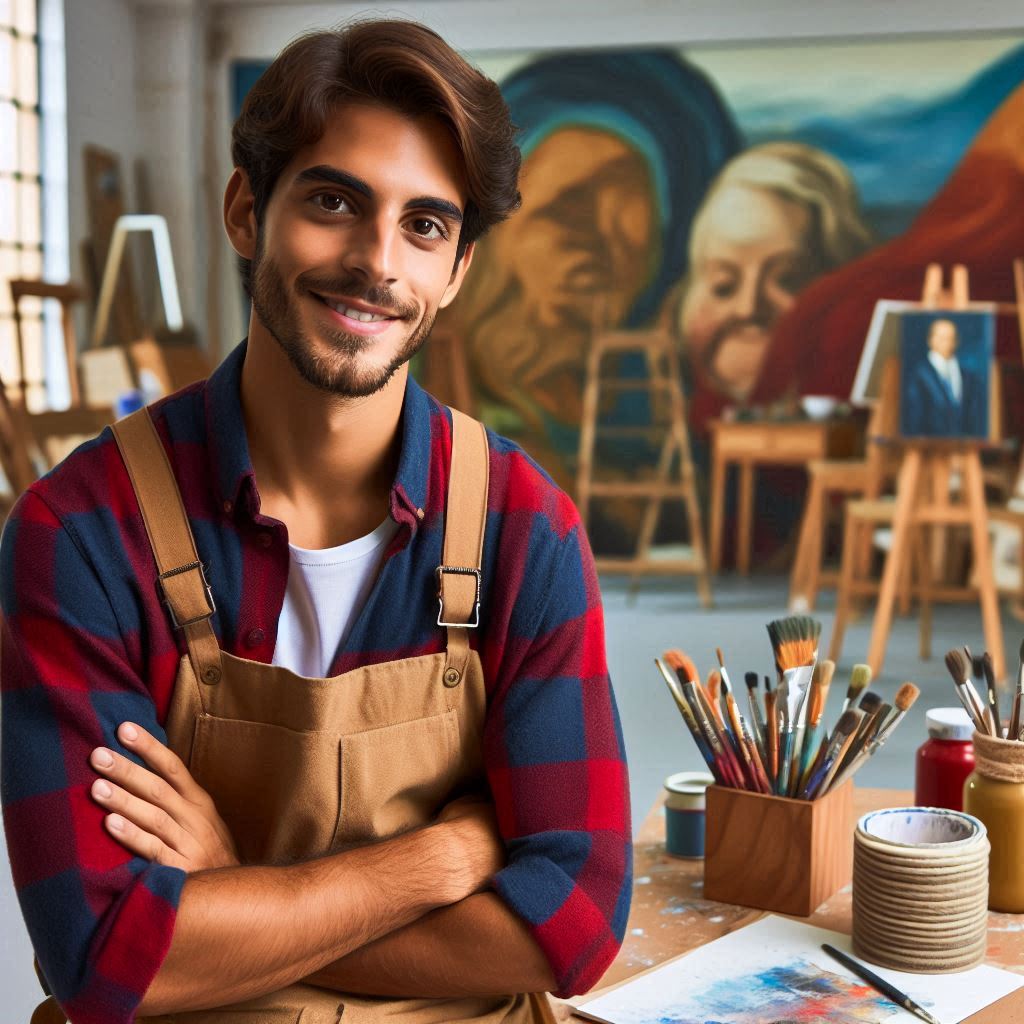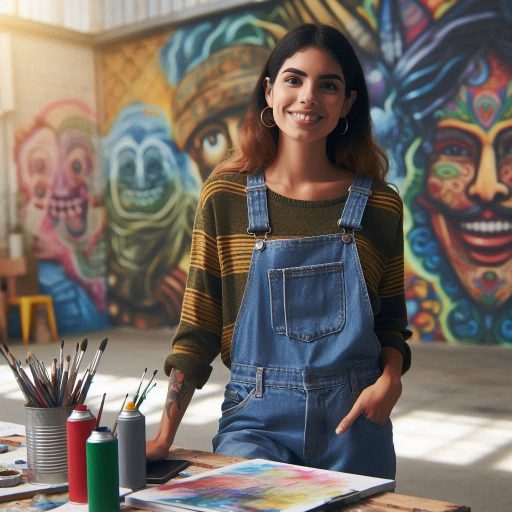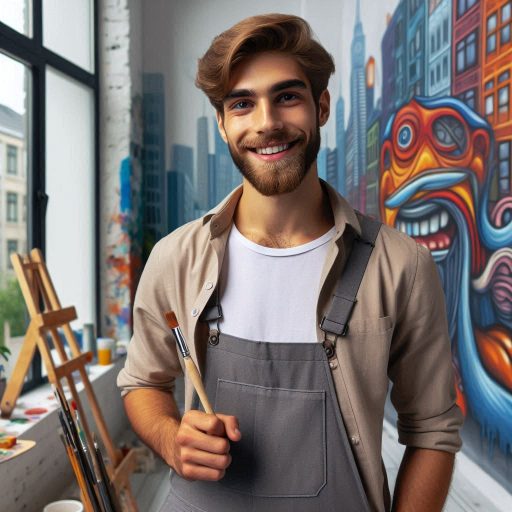Introduction
Mural art is a form of visual expression that involves painting directly on walls or surfaces.
It is a powerful medium that can transform spaces and convey powerful messages.
Mural art has been used for centuries as a way to communicate ideas, tell stories, and beautify public spaces.
It can range from simple designs to intricate and detailed artworks.
Mural art plays a crucial role in society by reflecting culture, history, and current events.
It allows artists to showcase their talent and create a dialogue with the community.
In this post, we will explore the step-by-step process of creating a mural, from sketching the initial design to painting it on the wall.
Let’s delve into the world of mural art techniques and discover how artists bring their visions to life.
Gathering inspiration
Researching different styles and themes
Mural art begins with a deep well of inspiration.
Artists should research various styles and themes to discover what resonates with them.
Explore traditional murals, street art, and contemporary designs.
Look into cultural influences that can enrich your work.
Online platforms, books, and galleries can provide valuable resources.
Visiting locations for mural placement
Visiting locations for mural placement is equally essential.
An artist should assess the site‘s atmosphere and community.
Take note of the architecture, colors, and textures surrounding the area.
Engaging with local residents can offer insights into community values and preferences.
This connection helps ensure the mural reflects the local spirit.
Creating mood boards and sketches to solidify ideas
Creating mood boards and sketches solidifies artistic ideas.
Collect images, color palettes, and textures that inspire you.
Transform Your Career Today
Unlock a personalized career strategy that drives real results. Get tailored advice and a roadmap designed just for you.
Start NowUse these elements to construct a cohesive visual narrative.
Sketching multiple concepts allows for experimentation with different compositions.
Artists can refine their ideas before committing to a final design.
Mood boards serve as a visual guide throughout the mural process.
They help maintain focus and direction, ensuring that the final piece aligns with your initial vision.
Sketches can evolve as you receive feedback, making room for new ideas and perspectives.
Inspiration fuels creativity in mural art.
A solid foundation of research, location visits, and mood boards leads to a successful mural.
By immersing yourself in diverse styles and community contexts, you create art that resonates deeply with viewers.
Your mural will not only beautify the space but also tell a story that connects with its surroundings.
Embrace this phase of gathering inspiration as a critical step in your artistic journey.
Read: Navigating Legalities: Permits and Contracts for Murals
Choosing materials and tools
When embarking on a mural art project, one of the crucial factors to consider is selecting the appropriate materials and tools.
From paints to brushes, each element plays a significant role in the final outcome of the mural.
Here are some key points to keep in mind:
Selecting appropriate paints
Whether your mural will be displayed indoors or outdoors, choosing the right type of paint is essential.
For outdoor murals, acrylic or latex paints are recommended for their durability and weather resistance.
These paints are designed to withstand the elements and retain their vibrancy over time.
On the other hand, indoor murals can be created using a variety of paints such as acrylics, oils, or watercolors depending on the desired effect and finish.
Showcase Your Business Today
Reach thousands of readers actively exploring professional services. Publish your business profile and grow your audience now.
Publish NowInvesting in quality brushes, sprayers, and other tools
Quality tools are essential for achieving a professional look in your mural art.
Investing in high-quality brushes will ensure smooth and precise application of paint, while sprayers can be used for larger areas and gradient effects.
Additionally, other tools such as rollers, sponges, and stencils can help add texture and depth to your mural.
Considering surface preparation and priming techniques
Before starting to paint your mural, it is important to properly prepare the surface to ensure that the paint adheres well and the colors appear vibrant.
This may involve cleaning the wall, repairing any cracks or imperfections, and applying a primer coat.
Priming helps to create a smooth and even surface for the paint to adhere to, resulting in a more professional finish.
By carefully selecting the right materials and tools for your mural art project, you can ensure that your creation will stand the test of time and leave a lasting impression on viewers.
Remember to experiment with different techniques and styles to find what works best for your unique vision!
Read: Inspiration Sources for Stunning Mural Designs
Planning the composition
When it comes to creating a mural, planning the composition is a crucial step.
By utilizing the golden ratio, you can achieve a balanced and visually pleasing composition.
This mathematical concept can help you determine the placement of elements within the mural to create harmony.
Utilizing the golden ratio for balanced compositions
The golden ratio, also known as the divine proportion, is a mathematical ratio that is often found in nature and art.
By incorporating this ratio into your mural design, you can create a sense of balance and symmetry that is aesthetically pleasing to the viewer.
Creating a detailed sketch or mockup of the mural
Before starting the actual painting process, it is essential to create a detailed sketch or mockup of the mural.
This will allow you to visualize the final outcome and make any necessary adjustments to the design before transferring it onto the wall.
Scaling up the design to fit the wall dimensions accurately
Once you have finalized the design, the next step is to scale up the sketch to fit the wall dimensions accurately.
This can be done using a grid system or a projector to ensure that the design is proportional and aligns with the surface area of the wall.
By following these steps and carefully planning the composition of your mural, you can create a visually stunning piece of art that will captivate viewers and enhance the space in which it is displayed.
Transferring the sketch to the wall
Using a grid system or projector to transfer the design
Transferring your sketch to the wall is a crucial step in mural art.
This process ensures accuracy and helps maintain the design’s integrity.
Artists often use a grid system or a projector for this purpose.
A grid system involves dividing both the sketch and wall into equal squares.
This method allows you to focus on one section at a time.
You can replicate the sketch within each square, ensuring accurate proportions.
This technique helps maintain the overall composition and details of the mural.
Alternatively, many artists prefer using a projector.
This tool casts the sketch onto the wall, providing a clear outline.
You can adjust the size of the image as needed.
Projecting allows for quick adjustments, making it easier to visualize the final design.
Outlining the main elements with chalk or paint markers
Once you have the sketch on the wall, outline the main elements.
Use chalk or paint markers for this step.
Chalk is great for temporary lines, allowing for easy adjustments.
Paint markers offer a more permanent solution if you are confident in your placement.
Ensuring proper proportions and alignment on the wall
Ensure proper proportions and alignment during this stage.
Double-check the dimensions as you work.
Maintaining accuracy in scale prevents distortions in the final mural.
Take your time to align all elements correctly.
Use a level to verify horizontal and vertical lines.
This tool helps you avoid slanting or uneven sections.
Showcase Your Business Today
Reach thousands of readers actively exploring professional services. Publish your business profile and grow your audience now.
Publish NowA well-aligned mural enhances its overall visual impact.
Transferring the sketch to the wall sets the foundation for your mural.
By using a grid system or projector, you create a solid base.
Outlining the main elements accurately ensures a stunning final piece.
Read: Public vs. Private Murals: Key Differences Explained

Painting techniques
When it comes to mural art, painting techniques play a crucial role in bringing the artist’s vision to life.
Whether you are a professional muralist or a beginner looking to explore this medium, understanding different painting techniques can help you achieve stunning results.
In this section, we will discuss three key painting techniques that can elevate your mural art:
Layering colors to create depth and dimension
Layering colors is a fundamental painting technique that allows artists to create depth and dimension in their murals.
By building up multiple layers of paint, artists can achieve a richer and more vibrant color palette.
To effectively layer colors, start with a base coat and gradually add additional layers to create highlights and shadows.
This technique adds visual interest and complexity to your mural, making it more dynamic and engaging.
Blending techniques for smooth transitions between shades
Blending techniques are essential for creating seamless transitions between different shades and colors in your mural.
Whether you are working with acrylics, oils, or spray paint, mastering blending techniques can help you achieve a smooth and gradual color gradient.
One popular blending technique is wet-on-wet painting, where you apply wet paint on top of wet paint to create a soft and blended effect.
Experimenting with different blending techniques can give your mural a professional and polished look.
Utilizing masking tape or stencils for clean edges
Creating clean and precise edges is crucial for achieving a professional finish in your mural art.
Masking tape and stencils are valuable tools that can help you achieve crisp and sharp lines in your compositions.
Before painting, use masking tape to outline the edges of your design and create a defined boundary.
Stencils can also be used to add intricate patterns or details to your mural with precision and accuracy.
By incorporating masking tape and stencils into your painting process, you can ensure that your mural looks clean and well-executed.
In short, mastering painting techniques is essential for creating visually striking and impactful mural art.
By experimenting with layering colors, blending techniques, and utilizing tools like masking tape and stencils, you can enhance the depth, dimension, and overall quality of your murals.
Whether you are a seasoned muralist or a novice artist, incorporating these painting techniques into your practice can help you take your mural art to the next level.
Experiment, practice, and most importantly, have fun with your mural art journey!
Read: How to Find Clients as a Freelance Mural Artist
Adding details and highlights
When it comes to mural art, adding details and highlights can truly bring your creation to life.
Here are some techniques to consider:
Incorporating texture with sponges or textured rollers
Texture can add depth and interest to your mural.
You can achieve texture by using sponges or textured rollers to apply paint.
This technique works particularly well for backgrounds or areas where you want to create a tactile experience for viewers.
Start by dipping a sponge or roller into your desired paint color.
Then, gently apply it to the wall in a dabbing or rolling motion.
Experiment with different pressures and angles to create varying textures.
This method can add a unique dimension to your mural and make it stand out.
Enhancing the mural with intricate details and patterns
Details and patterns can take your mural from ordinary to extraordinary.
Consider adding intricate designs, motifs, or patterns to various elements in your artwork.
This could include floral patterns, geometric shapes, or even abstract forms.
One way to incorporate details is by using fine brushes or even markers to outline shapes or add small embellishments.
You can also create stencils to help you achieve precise patterns.
Showcase Your Business Today
Reach thousands of readers actively exploring professional services. Publish your business profile and grow your audience now.
Publish NowJust remember that details should complement your overall design and not overwhelm it.
Adding highlights and shadows to make the design pop
Highlights and shadows can add dimension and drama to your mural.
By strategically placing highlights and shadows, you can create a sense of light and shadow in your artwork, making it more dynamic and realistic.
To add highlights, use a lighter shade of your base color and apply it to areas where light would naturally hit.
This could be edges, raised surfaces, or focal points.
For shadows, use a darker shade to create depth and contrast.
Blend these tones smoothly to create a gradual transition between light and shadow.
Remember, details and highlights should be used thoughtfully to enhance your mural without overpowering it.
Experiment with different techniques and have fun adding that extra touch to your masterpiece!
Sealing and preserving the mural
When it comes to mural art, sealing and preserving the artwork is essential to ensure its longevity and maintain its visual appeal.
Here are some key steps involved in this process:
Applying a protective sealant
- Choose a high-quality sealant that is specifically designed for outdoor use.
- Ensure that the mural is completely dry before applying the sealant to prevent moisture from being trapped underneath.
- Use a paintbrush or a sprayer to evenly coat the mural with the sealant, paying special attention to areas that are exposed to the elements.
- Allow the sealant to dry completely before touching or exposing the mural to any harsh conditions.
Regular maintenance and touch-ups
- Inspect the mural regularly for any signs of wear and tear, such as fading or peeling paint.
- Address any issues promptly by touching up the affected areas with matching paint colors.
- Consider scheduling periodic maintenance checks to assess the overall condition of the mural and make any necessary repairs.
Educating the community
- Organize workshops or informational sessions to educate the community on proper care and appreciation of the mural.
- Encourage community members to respect the artwork by refraining from vandalism or any actions that may damage the mural.
- Promote the cultural and artistic significance of the mural to foster a sense of pride and ownership among residents.
In a nutshell, sealing and preserving a mural involves more than just applying a protective sealant.
It requires ongoing maintenance, periodic touch-ups, and community engagement to ensure that the artwork remains a vibrant part of the urban landscape for years to come.
Explore Further: How to Handle Creative Block as a Director
Conclusion
We have explored various mural art techniques that transition from sketch to wall effortlessly.
From preparing the surface to sketching and painting, each step plays a crucial role in creating a stunning mural.
Murals have a profound impact on communities, transforming bland walls into vibrant expressions of culture, history, and creativity.
They serve as powerful tools for communication and storytelling, enriching the urban landscape.
I encourage readers to unleash their creativity and try their hand at creating their own mural art pieces.
Whether you’re a seasoned artist or a beginner, mural painting offers a unique opportunity to leave a lasting mark on public spaces and inspire those around you.
[E-Books for Sale]
The Big Book of 500 High-Paying Jobs in America: Unlock Your Earning Potential
$19.99 • 500 High-Paying Jobs • 330 pages
Explore 500 high-paying jobs in America and learn how to boost your career, earn more, and achieve success!
See All 500 High-Paying Jobs of this E-Book
1001 Professions Without a Degree: High-Paying American Jobs You Can Start Now
$19.99 • 1001 Professions Without a Degree • 174 pages
Discover 1001 high-paying jobs without a degree! Unlock career tips, skills, and success strategies for just $19.99!




